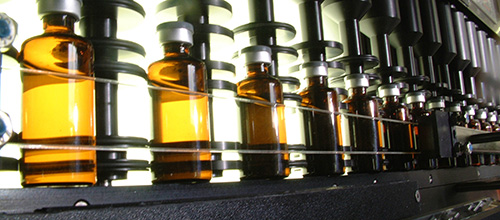Which Test Sets are used in the 100% Visual Inspection?
Recommendation

Thursday, 12 February 2026 9 .00 - 17.00 h
In the 100% visual control of parenterals required by the pharmacopoeias, so-called test sets (also called test kits) with different tasks and properties are used. But what are they and what needs to be taken into account?
Basically, the following sets are distinguished.
Qualification set
A qualification set is used for the qualification of manual (MVI) and semi-automatic (SAVI) visual inspection staff as well as for the qualification of a fully automatic machine (AVI).
A qualification set serves as a reference standard within the scope of qualification and can vary in its composition and size depending on its use (MVI, SAVI, AVI). The containers contained in the set should always be representative of the respective product or the typical defects in real production. Containers can be filled with real product or with optically and physically similar technical material.
In order to avoid a "bias" of the employees (MVI or SAVI) during qualification, it is important that the sets contain both particulate, non-particulate and "good" containers without defects. In addition to "static" defects (scratches, missing stopper, etc.) and units contaminated with certain particle types and sizes, these sets should have about 10% - 20% but less than 30% defective units. Novel faults or defects are added to the qualification set.
For the qualification of fully automated units, the sets can be divided into "static" and particle-containing defects in order to realise different qualification concepts.
For the assignment of units to the qualification of staff, all units should be invisibly or legibly marked with numbers or a code and regularly "blinded" anew to ensure that staff cannot remember the states of certain units. But be careful: simply marking the faulty containers with UV markers is easily recognisable by persons with a little experience and is not sufficient on its own to blind the patterns.
Training set
A set used for training manual and semi-automatic inspection staff to safely distinguish "good" from "defective" units. The structure is similar to a qualification set, but can be composed differently (more defect components, real defects collected from the product, etc.) and does not necessarily have to be approved by QA. For purely illustrative purposes, the set can also consist only of units with defects.
Functional set
The functional set (System Suitability Test Set) is used in the fully automated visual inspection before and after testing each batch to demonstrate the functionality of the fully automated system. It may contain an abbreviated set of obvious defects such as large particles, containers with cracks or empty containers.
Particle set
Particle test set (for the Knapp test): This test set contains only containers with particles and is typically used to qualify the machine for particle detection. The particles range in size from 50 µm to 1000 µm, and are made of various materials typical of production (stoppers, glass, metal, fibre, etc.). They are therefore "non-static", i.e. the defect lies in the container or in the medicinal product solution. When used in the context of human-machine comparisons, the set must still be filled with acceptable units (typically 80-90%) for the determination of the "detection rate human".
Worth knowing
The question often arises as to how a test set should be created, or whether it should be its own containers with product and defect, or whether the objects can be produced externally.
There is no general answer to this. Industry practice is to be as close as possible to one's own product, i.e. in the best case to use one's own product containers with representative defects. Many companies manufacture containers with static defects (e.g. cracks) themselves, and have one of the non-static defects (particle defects) manufactured externally.
In any case, whether manufactured internally or externally, the test sets should be checked and approved by QA.
The sets should be cleaned after use and routinely checked for defects at least every 6-12 months. Objects may need to be removed and replaced with new ones (QA approved). A container with a crack may last forever, but small particles could clump together. A logbook should be kept for each test set.




